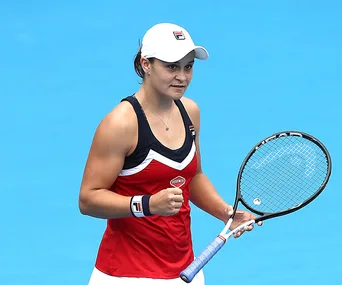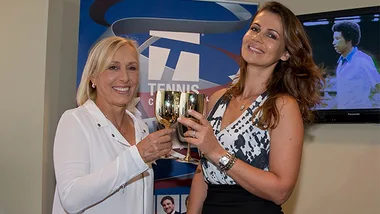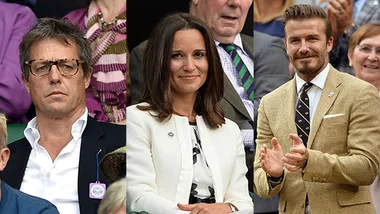With barely a bead of sweat on her brow, Ash Barty walked off the tennis court in Shenzhen last November and straight into a packed press conference, the eyes of the world’s media trained on her.
Minutes earlier she’d proudly held aloft the coveted Billie Jean King Trophy after winning the Women’s Tennis Association Finals, and with it the largest prize cheque awarded to any tennis player in history, male or female.
It capped off an extraordinary year for the 23-year-old, who won the French Open in June and became the number one female tennis player in the world soon after.
When pressed about how she’d spend the $6.4 million winnings, she shrugged her shoulders and said she’d “probably spoil” her three-year-old niece Lucy and two-year-old nephew Oscar with a new swing set for their Queensland backyard.
“I have everything I need,” she said before adding thoughtfully, “Money can’t buy time. The amount of zeros I have in the bank doesn’t change how I’m going to spend my off-season with my family,” a broad smile sweeping across her face at the thought of a cold beer on the back patio of her Mum and Dad’s home in Ipswich.
Those closest to her say this is Ash Barty, a Vegemite-loving girl-next-door who is as much at home playing backyard cricket as she is slaying the world’s best on a Grand Slam centre court.
And these genuine qualities have triggered a surge of interest in Australian tennis, the likes of which hasn’t been seen for decades, lovingly dubbed the ‘Ash effect’.
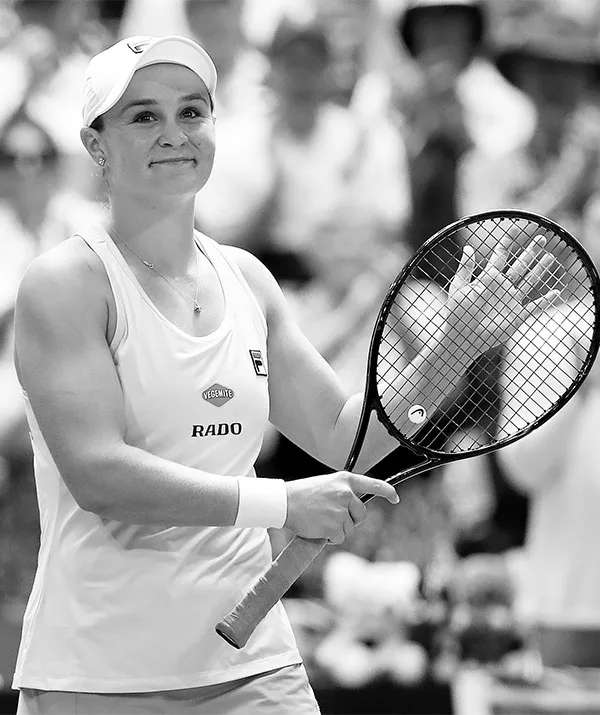
Ash Barty is the number one female tennis player in the worls.
(Credit: Getty)From record numbers of juniors taking to the court to bumper box offices sales for the Australian Open and a sense of self-belief sweeping through the ranks of the sport, Ash Barty is inspiring a golden age of Australian tennis.
“I’m just working as hard as I can to be the best I can be,” she tells The Weekly from her home in Queensland, where she is enjoying a few rare quiet days before launching her Australian Open campaign.
“It’s a beautiful game and it’s a privilege to play it.”
WATCH: Ash Barty’s post-match interview at the 2019 Sydney International. Story continues…
At home with Ash
It’s a warm summer Saturday afternoon and the world’s number one female tennis player is doing the vacuuming.
“I love cleaning!” she enthuses.
“I find it very calming and therapeutic, probably because I spend so much of my year in hotel rooms and I don’t get to do those normal things. So when I’m home, I turn on the TV or some music and off I go – I love it.”
One of the key things Ash learnt about herself during her highly publicised break away from tennis in 2015 was the need to find her “happy space”, the sense of “normal” she craves during the 40 weeks a year away from home.

Ash Barty is known for her down to earth presence both on and off the court.
(Credit: Getty)She often barely plants roots in a hotel room before jetting to the next tournament, and although she has established rituals to make herself comfortable, it’s never quite the same as feeling the couch grass between your toes and breathing in the salty Queensland air.
“This is where I recharge,” she says of the home she shares with partner of two years, Garry Kissick, and their Maltese cross Shih Tzu dogs, Affie and Chino, near Springfield on the outskirts of Brisbane.
“I’m the crazy dog lady who FaceTimes them while I’m away so they can hear my voice,” she laughs.
“I miss them like mad so I FaceTime them every day! Being here with Garry and the dogs and my family is the best way to cap off a week or celebrate a result, and being able to be home where my family is, I find I can really refresh myself quite quickly.”
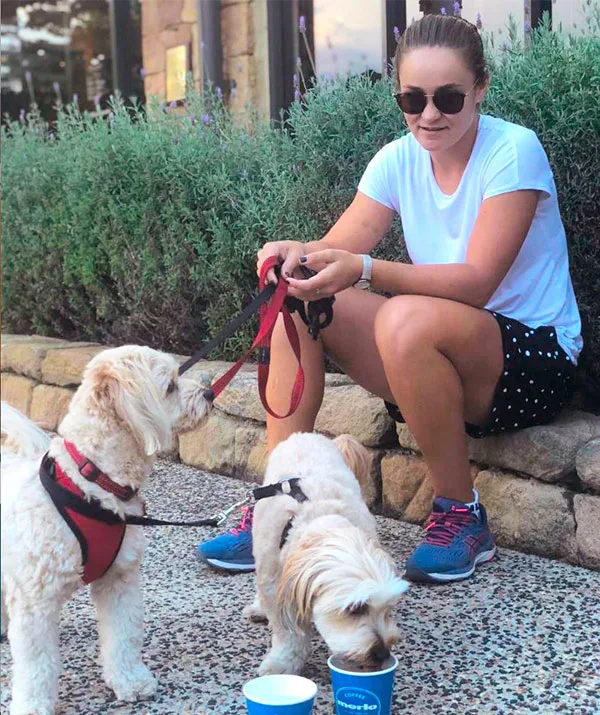
Ash Barty loves to spend down time with her dogs in Brisbane when shes not on the court.
(Credit: Supplied)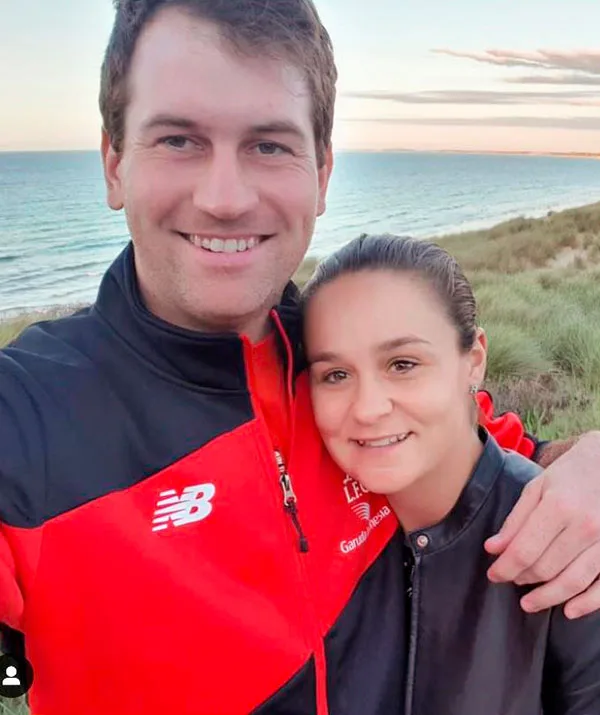
Ash Barty recharges by spending time with her family, friends, partner (pictured) and dogs.
(Credit: Supplied)At the age of 12, Ashleigh Barty was only half the size of most of her opponents.
That’s because she’d beaten everyone in her own age group and the age group above her.
Not yet a teenager, the pint-sized powerhouse was competing with boys 16 years and older, and barely giving them an inch.
By 14, she was on a plane to Las Vegas to meet Steffi Graf and Andre Agassi, where she got to train with Agassi’s legendary ‘secret weapon’, trainer Gil Reyes.
“It was a week in my life I will never forget,” she says.
“It was a lot of fun and at that age I was a sponge. I took a lot of information on board.”
A year later she won the junior Wimbledon crown. Hundreds of fans gathered to welcome her home at Brisbane Airport and virtually overnight a tidal wave of attention and expectation landed with a thud on her young shoulders.
Big things were expected of her, but the following year didn’t go to plan. She suffered niggling injuries and struggled to find form.
Exhausted and overwhelmed, after years on the road, she took a break from the game, retreating to the family’s Ipswich home to refresh her body and mind.
For fun, the talented athlete took up cricket and was snapped up by Brisbane Heat. She scored a stunning 63 runs in her second match.

Ash Barty with her idol Evon Goolagong.
(Credit: Getty)It was on the cricket pitch, under the Australian sun, that her love of tennis returned, and less than three years later, she became the world’s number one, the first Australian woman to achieve top ranking since her idol, Evonne Goolagong Cawley, in 1976.
“I took too much on board too young,” she says reflecting on the whirlwind time in her life after her Wimbledon win.
“I couldn’t filter what was right for me, but I’ve now learnt how to do that and I understand that pressure isn’t really a thing for me.
For me, competing is about trying to be the best I can be and if I give it a good crack and do the very best I can on any given day, that’s all that matters. Now all the white noise doesn’t really bother me too much.”

Ash Barty says life is more than just trophies.
(Credit: Getty)More than just trophies
Far from being a precocious child prodigy with pushy tennis parents, it was in fact Ash who begged her parents, Josie and Rob, to allow her to take to the court.
She’d mastered netball with her sisters, Sara and Ali, and was a dab hand at hockey too, but she loved “playing with sticks” and quickly found her feet on the tennis court.
Trophies soon began piling up at the Barty home but Sara says Ash insisted they be donated back to her local tennis club to be recycled.
“They’d take the plaques off and rebadge them for the next junior winners,” she says.
“Trophies have never meant anything to Ash. She played because she loved it.”
Today, not a single trophy graces the bookshelves of her home, there are no fast cars parked in the driveway, no flashy displays of her multimillion-dollar winnings.
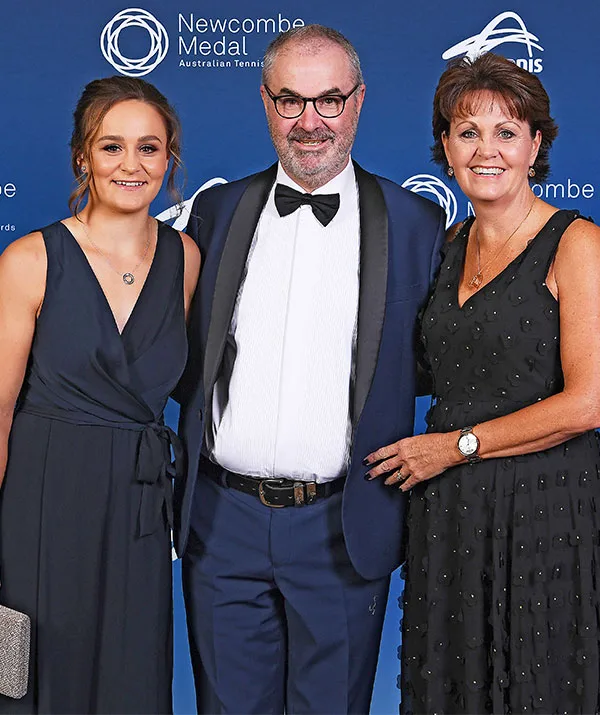
Ash Barty with her parents Robert and Josie Barty
(Credit: Getty)“The trophies are all at Mum and Dad’s – they enjoy them,” she says.
“When I come home it’s about being able to switch off tennis, to completely relax. Tennis for me is about the memories I make, more so than trophies – it’s never been about trophies.”
Tennis Australia Chief Executive Officer Craig Tiley says Ash Barty’s very genuine, down-to-earth charm is fuelling an unprecedented boom in Australian tennis.
“There’s no doubt about the Ash effect, no doubt!” he says.
“The evidence is in the numbers alone. There’s been a 29 per cent increase in kids joining tennis this year and the uptake of girls is exponentially higher than previously recorded. Ticket sales to the Australian Open are up 21 per cent on the same time last year. Those numbers are incredible.”

Ash Barty has represented Australia at Various international tournaments.
(Credit: Getty)“Ash is a superstar – the best in the world – but she’s a great person too and that’s a big part of her appeal. People love watching her play because she has such a beautiful game, but we love her character too. Australians are right on board Ash’s journey and she is creating a legacy which will last long beyond her own career.”
Federation Cup coach and tennis legend Nicole Pratt has witnessed the Ash effect first hand.
She struggled to get her five-year-old twin daughters Jamie and Matilda even vaguely interested in the sport that made her a household name, but upon returning from the recent Fed Cup tournament, she was stunned to be greeted with, ‘Mum, can we play tennis?’
“Matilda actually said the words, ‘I want to play like Ash Barty’. When I asked what she meant, she mimicked Ash’s stance, swaying slightly, her mannerisms and her return of serve. I was absolutely blown away.
“In that moment, I could see very clearly what Ash Barty is unwittingly doing, not just now, but for the future of tennis. There’s a palpable groundswell and a sense of excitement about tennis thanks to Ash. She is bringing a love of the game back to the masses and it will only go from strength to strength.”
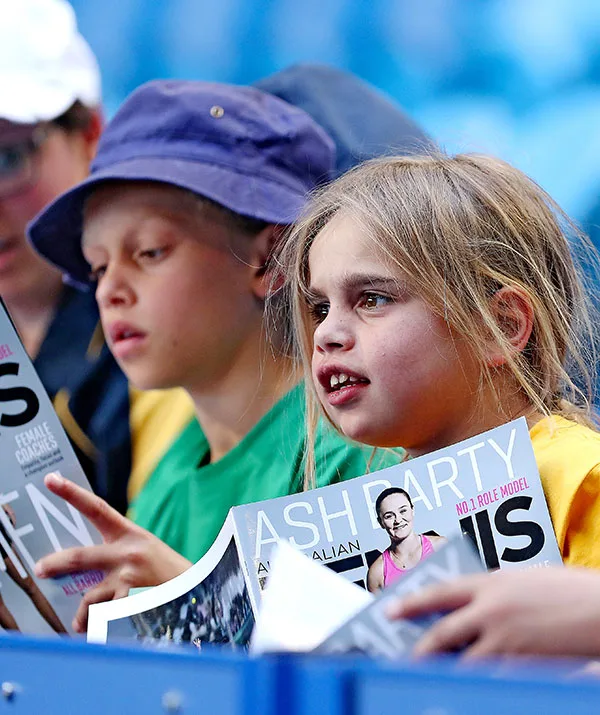
Ash Barty has become an icon for younger girls wanting to pick up tennis.
(Credit: Getty)The next generation
On a wet Sunday morning in December, when most of Melbourne is still fast asleep, the nation’s most talented young women tennis players have gathered in the boardroom at Tennis Australia HQ.
During a secret briefing, they analyse the strokes and techniques of their international rivals, swap war stories about individual players and share game intel in the hope this will give them the extra edge needed to follow in the footsteps of their mate Ash Barty.
It’s part of a long-term game plan Tennis Australia began implementing more than a decade ago to bring the top Australian players together as often as possible and create a sense of family, nurturing the juniors through the ranks and mentoring them closely.
The philosophy is to build the human being, as well as the player.
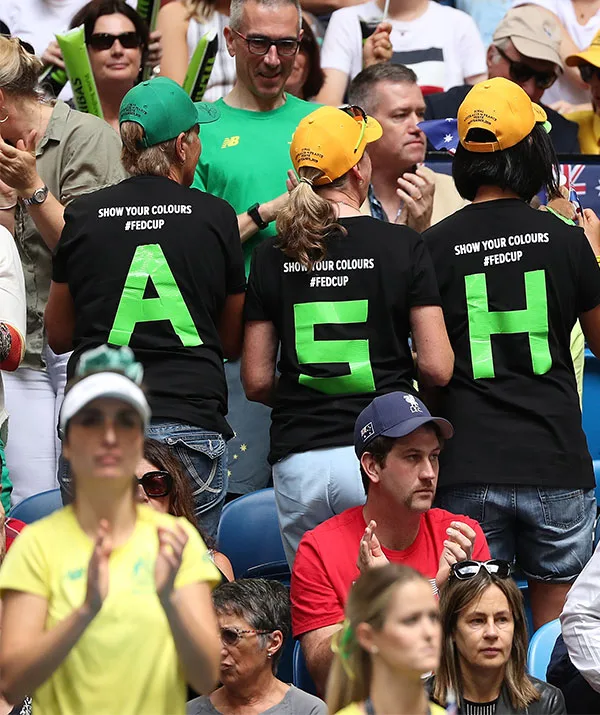
Support for Ash Barty has grown significantly since her tennis debut.
(Credit: Getty)“Ash’s success gives all of us a greater sense of self-belief,” says Queenslander Kim Birrell, 21.
“She lifts us all and gives us the confidence to believe that if we work as hard as Ash, we can follow in her footsteps.”
Kim has two International Tennis Federation singles titles to her credit, but like the others around the table, she’s looking for the big breakthrough.
Kim has trained with Ash for many years and says that she hasn’t changed from the day they met playing juniors in Queensland.
“She is so rare. She walks into the gym, chats about her dogs, chats with everyone about what’s going on in their lives. Sometimes you pinch yourself thinking, ‘Hang on, she’s the world number one, she’s a grand slam champion!’ But that’s Ash.”
Ash’s former doubles partner and close friend Casey Dellacqua, 34, says building stronger connections among the players has been game-changing.
When Casey was coming through the ranks, she knew teammates such as Nicole Pratt, Rennae Stubbs, Alicia Molik and Sam Stosur were looking out for her.
“It didn’t matter where I was in the world, if I needed help they were there day or night. Ash is already passing that on to the next crop of juniors and they will pass it on to the girls following them. There’s a very strong bond in Australian women’s tennis, and through Ash the younger girls see that success is achievable.”
It hasn’t always been this way.
When I spoke with Jelena Dokic for The Weekly in December 2018, she remembered feeling, as a teenager, that “tennis is a competitive sport and it’s hard to form close relationships with people on the circuit. Players keep to themselves.”
After Jelena’s experience, particularly off-court at the hands of her father Damir, Tennis Australia made a commitment to change.
That pledge extends beyond tennis; it has partnered with the federal government to launch #PlayForYou, a campaign to keep girls in sport after damning statistics revealed that one in three girls give up sport by the age of 18.
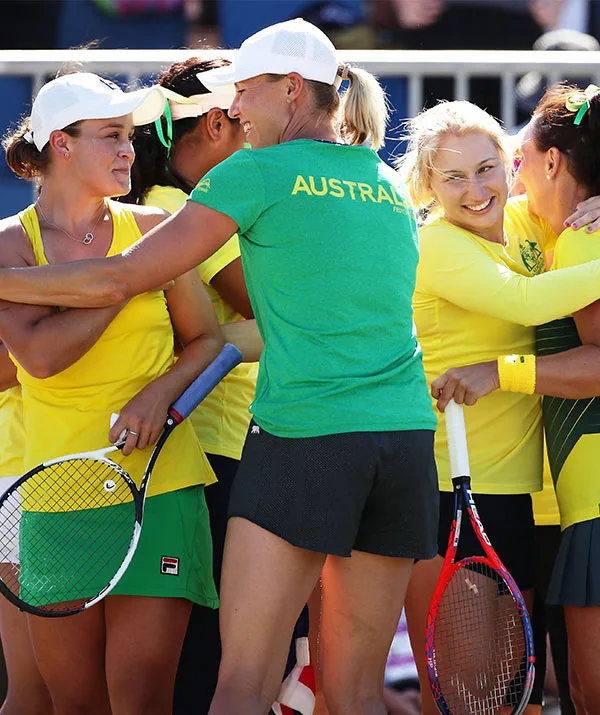
The #playforyou campaign aims to keep girls in sports after the age of 18
(Credit: Getty)Ash lends her voice to the campaign in addition to the many hours she spends off court mentoring young Indigenous students.
Federation Cup captain Alicia Molik says she believes that all these measures mean women’s tennis in Australia is in its richest place right now, with youngsters such as Astra Sharma, Ajla Tomljanovic, Priscilla Hon, Daria Gavrilova and Destanee Aiava nipping at Ash’s heels.
“Everything has aligned – quality players, quality coaches, quality support,” Alicia says. “We’ve set a culture for success and because of women like Ash, many others will reach their full potential too.”

Is Ash Barty the next Serena Williams?
(Credit: Getty)Taking on the world
Blue flags are flapping in the breeze around Melbourne Park screaming: “Come for the Barty, stay for the Party.”
The last Australian, male or female, to win an Australian Open singles title was Christine O’Neil in 1978.
It’s been a long time between drinks, but Craig Tiley believes that with the world number one in our ranks, it could be the year for a hometown hero.
“Winning a Grand Slam in your home country is very, very difficult and the pressures are significant. If we have an Australian playing in the final, man or woman, we may need to declare a public holiday, Australia will shut down,” he laughs.
1“It would be a very special moment in history. But, you know, regardless of how she plays at the Open, Ash Barty will be the same person day in and day out, and that’s what makes her so special.”
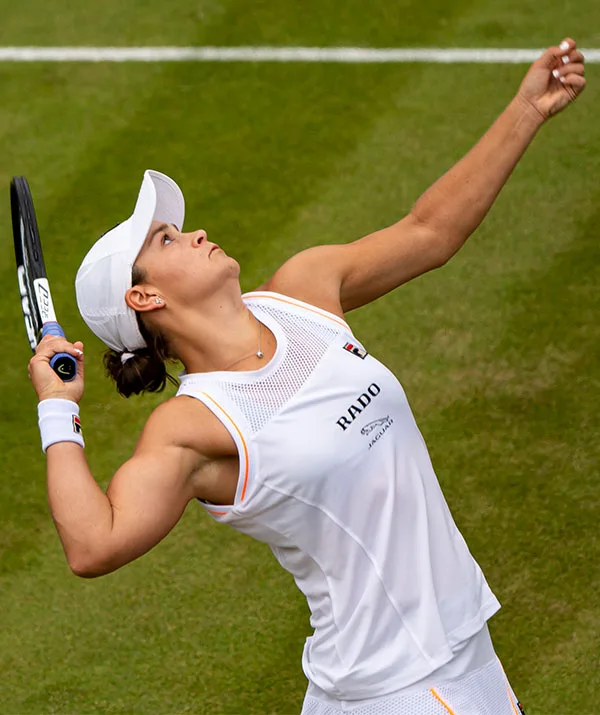
Ash Barty is pinned to win the next Australian Open.
(Credit: Getty)Marketing expert Con Stavros, an Associate Professor at RMIT University, says that far from just being a hometown hero, Ash has the ‘X factor’ needed to become a global sensation.
As the career of megastar Serena Williams comes to an end, he believes Ash is just the girl to step into her shoes.
“She looks like she has fun every time she steps out onto the court and that is so refreshing.Tennis is one of the world’s truly international sports, so the reach for someone of her talent is unlimited. She has all of the personal attributes, along with the immense talent, to be a global superstar.”
True to form, Ash Barty is unfazed by the ‘white noise’ swirling around her.
As Affie and Chino bounce at her feet, competing for attention, her immediate focus is the delivery of that precious swing set for Lucy and Oscar and getting to know the latest arrival in the family, newly born niece Olivia.
“Regardless of what happens on court, they always brighten my day,” she says, “and at the end of the day, I’m just Aunty Ash.”
2